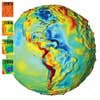“Dual-Displacement” Engine
It's two engines in one. Ford's dual-displacement engine runs on six cylinders for power, then switches to three for economy.
TIMELINE
January 1977: In 1977, the United States signs a treaty prohibiting international commerce in endangered species; balloon angioplasty is introduced as a treatment for heart disease; Tandy Corp. and Commodore introduce personal computers with built-in monitors; the first linked automated teller machines appear; Roots is broadcast on television.
As you cruise down the freeway, your engine smoothly shifts into fuel-saving mode, temporarily shutting down half its cylinders. The adjustment is almost transparent. When you need power, a computer control reawakens those sleeping cylinders, again almost imperceptibly.
As we reported in 1977, automakers have long sought an engine that on occasion hoards power in return for fuel efficiency. In the scenario described above, however, the word that has proved most elusive for automotive engineers is smoothly.
Heralding the arrival of this “dual-displacement” technology, we reported that a Ford 300-cubic-inch, six-cylinder truck engine would be equipped with computer controls that would disable half of those cylinders under certain conditions to save fuel.
Today, the technology remains challenging and its promise largely unfulfilled. We spoke with Ford’s recently retired James R. Clarke, who was in charge of the original project. Clarke cited as key hurdles rudimentary computer controls, low power-to-weight ratios, and difficulties in controlling vibration when the engine switched to half power.
Ford is continuing to pursue the elusive goal, says Ford senior technical specialist Chinu Bhavsar. Computer controls are more sophisticated, he says, and new “active engine mounting” is smoothing out the vibration difficulties. Noise-control technology is doing the same with exhaust noise. Ford isn’t ready to say when we’ll see dual-displacement in a production vehicle, only that it will be soon.
Among other carmakers, General Motors is planning to begin equipping large trucks and sport-utility vehicles with displacement-on-demand engines by 2004.
The idea isn’t new. An engine of this type first went into production in 1915, installed in the Schebler car. In 1917, the Enger “twin unit twelve” featured a two-displacement V12 that could be operated by a lever on the instrument panel. Since then, a number of copies have been made. But none has been successful.
Until now. The Ford Motor Company believes it has the right combination to make the idea work, And, according to present plans, Ford will have the engine in production within 24 months.
Called a technological breakthrough by Ford President Lee A. Iacocca, the dual-displacement engine will improve fuel economy by 10 percent. And that’s just the beginning. Later, with more precise tuning of the system, economy can be increased to twice that and more, depending on driving conditions.
The first engine to be converted will be Ford’s 300-cubic-inch six, which is standard in vans and light trucks. Dual-displacement engines for the family car will come later.
During most driving, the engine runs on six cylinders and delivers normal power. But when all engine functions meet a certain level — usually at cruise speeds greater than 45 mph — the engine switches to three cylinders.
Electronic logic
The heart of the system, according to Iacocca, is an electronic module that controls switching from six-cylinder operation to three- and back again. The module is about the size of a cigar box and fits under the hood, close to the engine. It has 68 discreet components and uses five integrated circuits. The module has a logic system that’s preprogrammed to do just one job — give the signal to switch engine modes.
On the engine itself, all changes take place within the valve cover. The complete mechanical system for switching each cylinder is small enough to fit in your hand and weighs about a pound. The switching unit consists of a solenoid and a valve bypass located on top of each of the front three cylinders.
During six-cylinder operation, this mechanism lets all valves operate just as they would in a conventional engine. Meanwhile, the electronic control module constantly monitors engine functions. When five critical conditions are met (water temperature greater than 180 degrees, transmission — automatic or manual — in third gear, intake-manifold vacuum above 9 inches of mercury, throttle angle less than 55 degrees, and vehicle speed above 45 mph), the computer actuates the solenoid. That closes the valve to three cylinders, effectively sealing them. They take in no air-fuel mixture and exhaust no gases. (This mechanical system was developed in cooperation with the Eaton Corp.)
The trapped air inside the closed cylinders has no effect on the power or emissions of the engine. It acts like an air spring, simply compressing and expanding as the piston moves up and down. The absence of compression braking in these cylinders contributes to (a freewheeling effect.) Only compression from the three working cylinders is available to act as resistance during deceleration.
“Drivers will notice this loss,” said James R. Clarke, Ford’s man in charge of the project. “But,” he noted, “it’s like the period when drivers were switching from manual to automatic transmissions. The coasting effect of the automatics was a sharp contrast to the slowing effect of the manual transmission.”

Seals from Space Sea creatures are our next army of environmental-data collectors

Arctic MeltdownRipples mark a dramatic 3-D view of a shrinking glacier

No Silver LiningsA giant, polluting, climate-tampering cloud stalks the U.S.

It’s Cold at the TopIf the world is getting stormier, these satellites could show it

Global Warming Means Massive ChangeThe first satellite to measure subtle differences in Earth’s gravitational field is helping s

Red Hot Clouds Scientists scrutinize “hot towers” to predict nightmare storms

Crop Circles–in a Near-DesertAgriculture is transforming landscapes in the water-strapped West